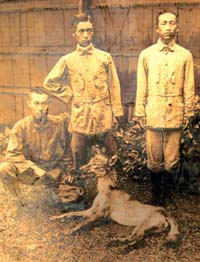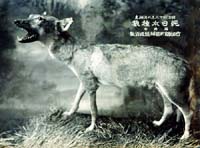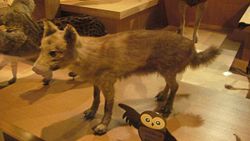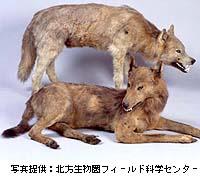Revisiting The Honshū Wolf
Posted by: Loren Coleman on October 24th, 2008
In a world of increasing documentary treatments of international cryptids, one hidden animal that I feel should be highlighted more is the Honshū Wolf of Japan.
Let’s revisit this Mystery Canid.

An update worth mentioning is that I was able to finally find a small replica of the Honshū Wolf of Japan (shown above). I actually obtained two figurines, so I could send one back to Japan in thanks to researcher Brent Swancer. He had not been able to track one down yet, so since he had generously shared his translations on the cryptid below, it seemed only right he should have a figurine of the cryptic wolf.



The world’s smallest variety of wolf, the Japanese wolf, also called the Honshū Wolf (Canis lupus hodophilax), supposedly became extinct in 1905 in Nara prefecture, Japan. But did some survive beyond that date? And was there physical proof of this event, in 1910, in Fukui prefecture?
Sightings of the Japanese wolf persist to the present, and yet, even the date of the “last one” is in dispute. A new debate is occurring currently in Japan that the extinction date may have been incorrect, almost immediately.
Intriguingly, finding a taxidermy example of the Honshū Wolf presently is quite difficult. Only five mounted specimens are said to be known worldwide: three in Japan, one in the Netherlands (which is pictured in the beautiful book, Swift as a Swallow), and the supposedly final 1905 animal, which is located at the British Natural History Museum.
But was there another taxidermy mount that proved these wolves lived beyond 1905?
In Japan, a 2007 Asahi News discussion surfaced regarding the photographs you see here. I am grateful to cryptozoology historian American Brent Swancer (who lives in Japan) for passing along to me information and his translation.
Supposedly killed in 1910 in Fukui, the Japanese wolf in the first of the three above photographs is apparently genuine. The article explains that the last officially known Japanese wolf died in 1905, yet here is one that was allegedly killed five years later, in 1910.
Unfortunately, the body was destroyed in a fire, according to the article. The picture in the middle is a taxidermy-mounted specimen of that last known Japanese wolf and the photo at the bottom is the farm where the wolf was shot in 1910.
The two photos of the dead animal today remain as the only real evidence that this wolf existed since the body has long since been destroyed.
In the Asahi News article there is a mention that in an issue of the Fukui agricultural magazine of the time, zoo staff had examined the animal the day after the shooting in 1910. They came to the conclusion that it was indeed a Japanese wolf. Unfortunately, it seems that that is as far as the examination went. It appears that those who advocate that this was a Japanese wolf point to that Fukui magazine article, as well as comparing the morphology of the animal pictured to data on the Japanese wolf. But it is inconclusive and not enough to change the common historical record that the last known specimen died in Nara in 1905. Brent Swancer

The mounted Honshū Wolf (Canis lupus hodophilax) in the National Science Museum of Japan.

The closely related elusive Hokkaido Wolf (Canis lupus hattai).
About Loren Coleman
Loren Coleman is one of the world’s leading cryptozoologists, some say “the” leading living cryptozoologist. Certainly, he is acknowledged as the current living American researcher and writer who has most popularized cryptozoology in the late 20th and early 21st centuries.
Starting his fieldwork and investigations in 1960, after traveling and trekking extensively in pursuit of cryptozoological mysteries, Coleman began writing to share his experiences in 1969. An honorary member of Ivan T. Sanderson’s Society for the Investigation of the Unexplained in the 1970s, Coleman has been bestowed with similar honorary memberships of the North Idaho College Cryptozoology Club in 1983, and in subsequent years, that of the British Columbia Scientific Cryptozoology Club, CryptoSafari International, and other international organizations. He was also a Life Member and Benefactor of the International Society of Cryptozoology (now-defunct).
Loren Coleman’s daily blog, as a member of the Cryptomundo Team, served as an ongoing avenue of communication for the ever-growing body of cryptozoo news from 2005 through 2013. He returned as an infrequent contributor beginning Halloween week of 2015.
Coleman is the founder in 2003, and current director of the International Cryptozoology Museum in Portland, Maine.










Another picture of the big strong hunters killing the big bad wolf.
It must’ve been a wonderful world before we humans came on the scene and started killing everything.
From the land of the subcompact car: the subcompact wolf.
According to press reports I used in writing the wolf chapter of my book Shadows of Exstence, there is also a Japanese shrine holding an animal whcih may have been presented to it as late as 1950. One forester wrote that the animal may have survived and even increased during WWII, when the human population in many rural areas declined, but finally succumbed in the 1950s or 1960.
Nice article – don’t suppose there’ve been any more recent alleged sightings like in the case of the Tazmanian wolf?
The face and the head to body ratio looks much like another cryptid/extinct critter of Australia (thylacine). I know the thylacines are/were marsupials, but isn’t the resemblance amazing? I believe X-Files did an episode about this one, except the creature became scientist who thought he captured one. I don’t remember if they actually said if it was the power of obsession or the actual spirit of the wolf that caused the scientist to morph into the wolf. Here’s hoping that somewhere a group did survive.
wolf, coyote or fox?
shumway10973, a thylacine was the first thought that cropped into my mind when I viewed the figurine at the top of the page. The resembalance is indeed remarkable, I just hope both these critters are still with us, are confirmed and then protected.
I was away from the site for a few weeks and boy am I happy to come back and see this revisited! This animal is one of the most fascinating Japanese animals for me and I am honored to have helped Loren translate this article for him to post. I still unfortunately haven’t been able to find a living one, however the figurine has a prominent place in my study. It’s actually very hard to find any sort of Honshu wolf paraphernalia like that figurine, so it was very cool.
As for whether they still exist, I still hold out hope that the Honshu wolf and Hokkaido wolves are still out there, and I believe there is a decent chance they just might be. Reliable reports have cropped up in recent years that are at least promising, and there has been the occasional physical evidence turned up such as hair, scat, and kills. One of the main problems I think is that the wolves resemble (indeed are likely related in some way to) some of the Japanese breeds of dog such as the Akita , and in conjunction with the fact that a lot of Japanese are aware the wolf existed yet don’t known exactly what it looked like, some sightings might be attributable to domestic dogs or feral strays seen under certain conditions. Even still, there are some very compelling cases, including actual specimens that were reportedly collected. For instance, one man allegedly actually found a wolf cub and kept it for a short time before turning it lose out of fear the mother would come looking for it.
The terrain is there, the ecosystem is ripe for a keystone predator such as the wolf, and Japan has a lot more remote areas than many people think. If the wolf could be located and brought back to its past numbers, it would be great for the ecology, as deer are in overabundance here and causing a good deal of problems in some areas. Ecosystems need top predators to remain healthy, and Japan is distinctly lacking an animal to fulfill the particular niche left by the wolf. Some want to reintroduce wolves other than the extinct Japanese variety, but I am somewhat against the idea due to the fact that it would almost certainly be detrimental to any Japanese wolves that may still remain.
A few responses to some posts.
sschaper- They are wolves. Depending on who you ask, they are a subspecies or their own separate species as some zoologists argue.
coelacanth1938- It was mostly the Hokkaido wolf that was directly slaughtered in response to the perceived threat they posed to the ranches that were becoming ubiquitous in the region at the time. A huge poisoning campaign did a lot of damage, and the wolves were shot whenever possible. The Honshu wolf met a more roundabout fate. Although attitudes had been changing and new farming techniques were causing more friction between humans and wolves, rabies was the main factor in the demise of the Honshu wolf. Domesticated dogs caused a rabies epidemic, which not only killed the wolves, but caused irrational fear of rabid wolves running amok which wasn’t good for its image at all and made the wolves more of a target. The really sad thing is that these wolves were at one time revered and even worshipped in Japan.
MatteBille- I read your book recently and thought you did a great job on the section pertaining to Japanese wolves. Nice work.
Once again, thanks to Loren for the figurine and for revisiting this very special topic for me.
I think that the term “wolf” has to be a broad, flexible designation, because of the extreme flexibility and genetic plasticity of the dog family. The “species barriers” (which are manmade conveniences, after all) just don’t hold true for a lot of canine species. Wolves (including coyotes), jackals, dogs, and dingos can interbreed and produce fertile offspring (which is an older definition of a single species), yet they are obviously different enough, physically and behaviorally, to be assigned to different species.
I believe that is a large part of why dogs – domestic dogs – are so wonderfully diverse – they have had thousands of years and this large, worldwide gene pool from which to evolve. I do not consider them to be a wolf subspecies, but instead they are a species unto themselves, closely related to gray wolves but also to many other species of wild canine.
Some of the indigenous Japanese dog breeds, especially the Shikoku Inu shown here (http://japanesedogs.bulldoginformation.com/shikoku-inu.html) look very much like the extinct Japanese wolves and are probably descended (at least in part) from them.